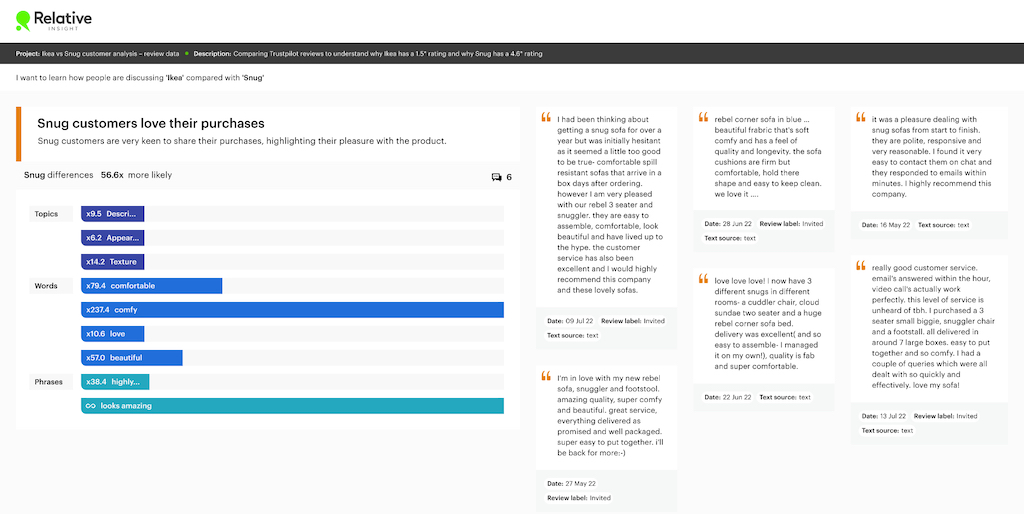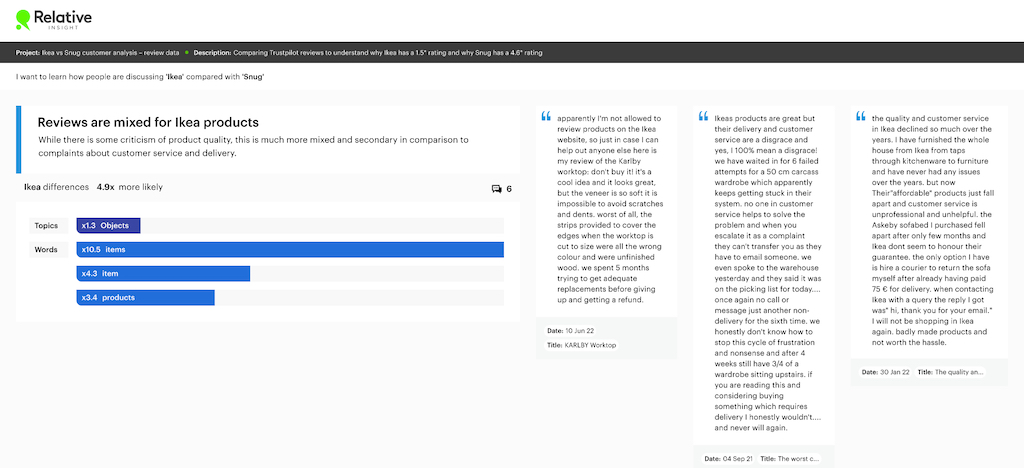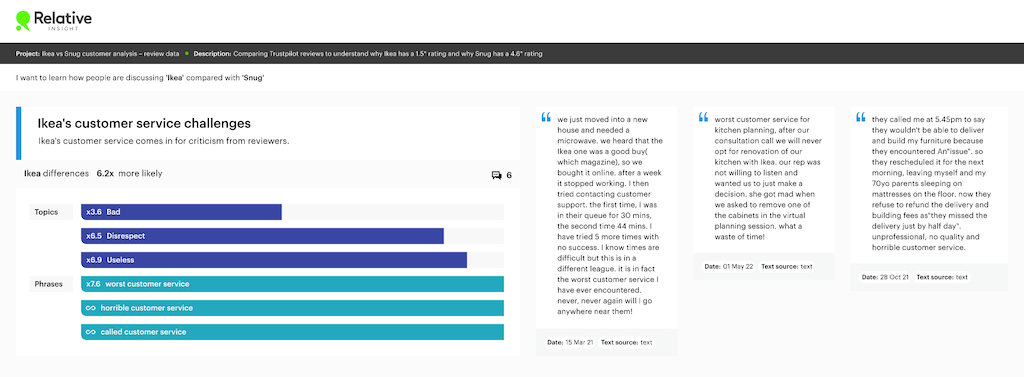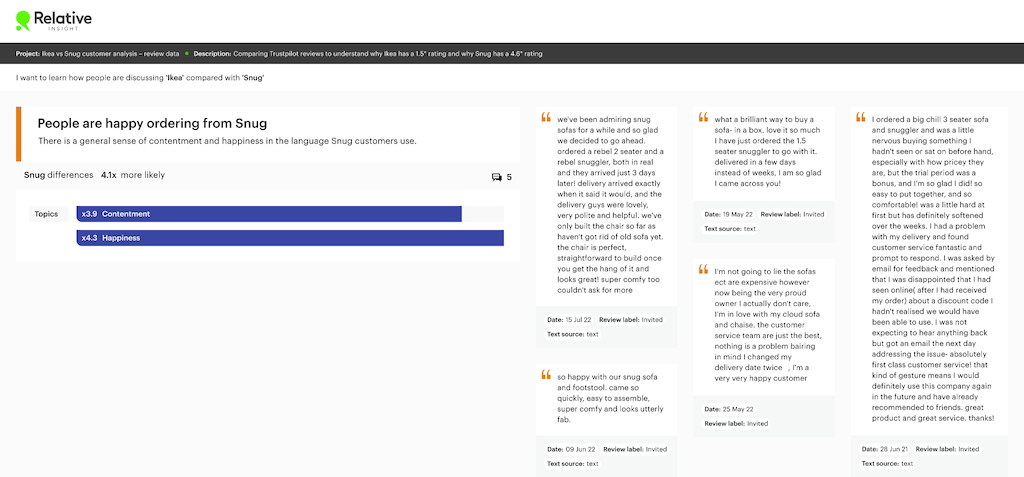Using Snug and Ikea Trustpilot reviews to analyze customer feedback
When it comes to flat-pack or boxed furniture, chances are the first brand that springs to mind is Ikea. This global juggernaut has built its reputation on practical, affordable products, yet it must always analyze customer feedback to maintain its position and address any concerns.
If not, competitors such as boxed sofa brand Snug, can take the opportunity to eat into its market share. Despite being only four years old, the retailer ranks highly on Trustpilot with a rating of 4.6 stars out of 5. This is in contrast to its established Swedish counterpart, which only gets 1.5 stars out of 5. However, these ratings only tell part of the story. Each brand needs to delve into the text contained in the reviews accompanying these numbers to find out why customers gave them that score, in order to help them ascertain what to do about it.
With each furniture store garnering thousands of reviews, manually combing through these responses to find customer insights would be laborious. Basic visualizations such as word clouds have traditionally been used to gain simple understanding – but these would only ever be likely to surface words like ‘bed’, ‘sofa’, and ‘furniture’ – and that doesn’t really explain anything.
Relative Insight customer insight platform uses comparison to perform a robust customer insights analysis. By uploading each brand’s reviews into our text analytics tool, we are able to highlight the differences in reviews for a 1.5-star rated company and a 4.6-star scoring brand. This unbiased analysis helps brands to understand the why and how, as well as the what.
Snug and Ikea Trustpilot reviews: People prefer Snug’s products, but this isn’t the reason for the difference in score
At first glance, the gulf in both brands’ scores would suggest that it’s their products that separates the two. While the way customers talk about both brands’ products is different, this isn’t the full story.
Snug’s customers are effusive in their praise and are highly descriptive when it comes to their boxed furniture. They are 9.5x more likely to use descriptive words and describe its appearance 6.2x more often. They use the word ‘beautiful’ 57.0x more and are infinitely more likely to say the product ‘looks amazing’ – which means this phrase doesn’t appear in Ikea’s reviews at all.

“rebel corner sofa in blue … beautiful fabric that’s soft comfy and has a feel of quality and longevity. the sofa cushions are firm but comfortable, hold there shape and easy to keep clean. we love it ….“
Given Ikea’s reputation for functional, reasonably priced furniture, it’s not a surprise that customers are less descriptive about what they buy. While they are 3.4x more likely to use product-related words, these tend to be basic descriptions like ‘items’. Discussion about the product is mixed, with some reviewers complaining about poor quality or damage.
“so just in case I can help out anyone else here is my review of the Karlby worktop: don’t buy it! it’s a cool idea and it looks great, but the veneer is so soft it is impossible to avoid scratches and dents.“

However, while customers aren’t salivating over their Malm furniture, it’s also certainly not a turn-off. Customer mentions of Ikea’s products tend to be grouped with other aspects of its service.
“Ikeas products are great but their delivery and customer service are a disgrace and yes, I 100% mean a disgrace!“
Snug and Ikea Trustpilot review analysis highlights Ikea’s customer service and delivery challenges
As highlighted in the above verbatim gleaned from our customer insights platform, Ikea’s 1.5-star rating appears to have arisen from customer service and delivery issues. Ikea reviews were more likely to use words around ‘disrespect’ and ‘rudeness’ (6.5x), ‘uselessness’ (6.9x) and ‘being bad’ (3.6x). Customers were 7.4x more likely to use the phrase ‘worst customer service’ and infinitely more likely to say ‘horrible customer service’.
“worst customer service for kitchen planning, after our consultation call we will never opt for renovation of our kitchen with Ikea. our rep was not willing to listen and wanted us to just make a decision.“

This stands in stark contrast to Snug. While our customer insights found that reviewers did cite some challenges with ordering and delivery, these were resolved satisfactorily. They were 14.6x more likely to use the phrase ‘great customer service’, and 4.7x more likely to use the word ‘helpful’.
“great customer service team, special thanks to Holly! if you have any queries and/or issues at all, she will be able to help 100%, super quickly, politely and overall is very, very, very helpful.“

There’s also a disparity in descriptions about delivery. This is another bugbear for Ikea customers, who were 2.4x more likely to use words surrounding ‘lateness’ and used the word ‘waiting’ 3.0x more often. They also used the phrases ‘never showed’, ‘new delivery date’ and ‘wait time’ infinitely more.
Meanwhile, Snug customers praised the company’s unconventional furniture-in-a-box offering. They were 13.2x more likely to use the language of ‘ease’, including the words ‘easy’ 27.0x more often and ‘quick’ 18.6x more than Ikea customers. They also used the phrase ‘quick delivery’ 53.7x more often and were infinitely more likely to describe the process as ‘super easy’.
Snug and Ikea Trustpilot reviews: Customer insight platform highlights emotive responses
Through conducting customer feedback analysis for both brands, it’s clear that they’ve generated emotional responses from their customers. People ordering boxed furniture from Snug are 3.9x more likely to use the language of ‘contentment’ and 4.3x more likely to use words describing ‘happiness’.
“we’ve been admiring snug sofas for a while and so glad we decided to go ahead.“

Ikea’s customers exhibited a negative emotional response. They were 1.5x more likely to express ‘frustration’ and 2.3x to use words around ‘disliking’ the brand. They were also infinitely more likely to use the phrase ‘never shop’, conveying their displeasure to the point they won’t return to the retailer.
“I’m so exhausted after this experience…. sitting here in tears and thought I’d warn others.“

How to analyze customer feedback to take action
Relative Insight’s customer insight platform has helped to uncover the reasons behind the extremely different Snug and Ikea Trustpilot reviews, and it’s mainly all down to customer experience.
While these customer reviews will make uncomfortable reading for Ikea, any brand undertaking customer review analysis should understand that knowledge is power. By using a text analysis tool to look beyond the 1.5 star rating and gather customer insights examples like these, the retailer now understands that delivery and customer service are real pain points for consumers – and can take action to rectify this.
Boxed furniture retailer Snug will be pleased when it analyzes the customer feedback contained in these reviews. However, these customer insights should also give it food for thought. With a greater number of people recommending its products and service, it will need to consider how it maintains this standard as it grows, particularly as some consumers have experienced delivery issues akin to Ikea – the difference being that Snug’s customer service team has mitigated this challenge.
Quantitative data tells you the what. Qualitative text data tells you the why and how. Combined, both data sets reveal your brand’s complete story and allow you to formulate and present a compelling plan of action.
